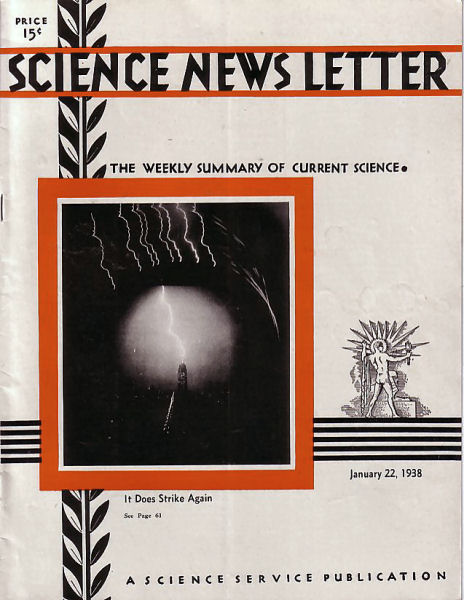From the January 22, 1938, issue

LIGHTNING STROKES CAUGHT BY A ROTATING CAMERA
Lightning does strike twice and more than twice in the same place, it is demonstrated by the photograph appearing on the front cover of this week’s Science News Letter. Eleven separate strokes make up what appears to the eye as a single lightning flash.
The strokes, which come so fast that the human eye cannot distinguish them, were photographed by General Electric Co. scientists. The Empire State Building in New York City is the target.
The flash as the human eye sees it (main flash in center) was caught by one camera lens, while another one, rapidly rotating, caught the 11 separate strokes. The first one is the streak at the right, the last one is at left. The flash took 0.36 second altogether.
OCEANS HALF BILLION YEARS OLD, THEIR SALT TELLS SCIENTISTS
The Earth’s salty oceans are some 500 million to 700 million years old, almost double the accepted previous estimates, Drs. A.C. Spencer and K.J. Murata, of the U.S. Geological Survey, have concluded after an intensive study of oceanic chemistry.
Before the turn of the century, geologists determined the age of the oceans by dividing the amount of salt in them by the amount added each year. This was based on the idea that all the salt brought to the oceans by rivers stayed there. Such an early determination of age, after hundreds of surveys and analyses, was about 100 million years. Later research brought the age to 350 million years, but such figures were found to be too small. Dinosaurs are now known to have existed about 100 million years ago, and oceans obviously existed long before that.
Studying the action of clay on salt water, Drs. Spencer and Murata in the recent work have found that some of the salt carried to the oceans is removed by clays, and deposited on the sea floors as a compound that does not easily dissolve. Correcting the old figures for this salt removal gives them the new age figure of 500 million to 700 million years.
The geologists who measure the Earth’s age by the products of the decay of radioactive elements are expected to say the new ocean age estimates are too small. They pronounce the Earth at least 2 billion years old. While the Earth in its earlier stages may have been oceanless, there is in the radioactive age figures plenty of room for even more ancient oceans.
YOUTH AT THE WHEEL FOUND SKILLFUL BUT A GREAT HAZARD
The flaming younger generation stands condemned as the greatest group of mass murderers in America. The weapon is the automobile.
Although including more highly skilled automobile drivers than any other age group, 100,000 drivers between 16 and 20 years of age kill nearly twice as many on the road as the average 100,000 drivers.
Accident rates for those below 25 years of age are so high that bringing down that age group’s accident rate to the general level would save nearly 8,000 of the nearly 40,000 killed each year on the American highway and street.
These challenging figures were presented to the American Association for the Advancement of Science by Dr. Harry M. Johnson, research associate for the Highway Research Board, Washington. Young men between 19 and 21 years of age are apparently the worst menaces on the highway, Dr. Johnson declared, pointing to a chart which indicated plainly that young men just approaching their majority are responsible for many more accidents per 100,000 drivers than any other group.







